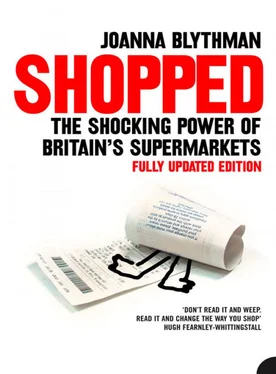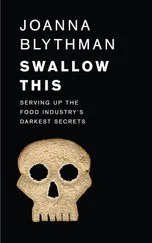As the DETR Select Committee noted, supermarket blight has been most pronounced in smaller towns, villages and rural areas. By 2000, the Countryside Agency was saying that seven out of ten English villages had been left without a shop. In 2001 the Rural Shops Alliance found that there were fewer than 12,000 rural shops left in the UK; and, according to The Grocer magazine, these were closing at the rate of 300 a year.
The haemorrhage of small independent shops that started in the 1980s and accelerated throughout the 1990s has settled down to a steady drip in the last couple of years. In 2001, net closures amongst smaller newsagents, for example, were running at the rate of almost one a day. The Institute of Grocery Distribution has reported that there were 953 fewer convenience stores in the UK in 2001 than there were in 2000: a 1.7 per cent drop. It predicts that this trend will continue, with another 3,700 shops disappearing by 2006.
As far as our large supermarkets are concerned, such effects are just the natural law of the retail jungle. If local shops, even smaller supermarkets, close, so what? Small-scale retailing RIP. As one supermarket expert put it: ‘The supermarket groups are running businesses. The success of superstores shows that they are meeting the needs of shoppers, at least the majority of them. The retailers have discovered the right business model, recognized the opportunity; government policy let them rip. People want to use their cars and will do so whenever possible.’
Mention the words ‘parking’ or ‘pedestrianisation’ to independent shopkeepers and be prepared to stand and listen for some time. They feel a huge sense of injustice at the large supermarket chains’ free-parking advantage over town-based shops. They see themselves as victims of pseudo-environmental town planning, selectively applied. Consumers can drive to out-of-town superstores and park for free. But if they would prefer to spread a significant amount of their household shopping around local shops, either they will need strong arms to transport heavy shopping by foot – in 2000 the average family food shopping weighed around 36 kilos – or they will have to cruise round patiently in their cars to find one of a diminishing number of parking spaces. When the DETR’s Select Committee looked at this issue, it confirmed the disadvantage that small shopkeepers feel so intensely. ‘The large amounts of free car parking offered by existing out of town supermarkets gives them an enormous competitive advantage over city-centre stores. In addition, supermarkets at these sites generate more car use, making the situation on already congested roads worse. The situation needs to be addressed urgently,’ it concluded. To redress this obvious injustice, Deputy Prime Minister John Prescott mooted the idea of a tax on supermarket parking. Supermarkets would have had to pay something back to the country for their acres of free car parks. But the supermarkets lobbied successfully to have this proposal dropped. Hence the current status quo in which supermarkets dangle a free-parking carrot to consumers while local shops and their potential customers dodge vigilant traffic wardens keenly enforcing their council’s green-sounding, leave-your-car-at-home policy.
For the small, local shops that remain, survival gets ever more complicated too. Small shops have to try to survive a campaign of attrition. Throughout the 1980s and 1990s they had to see off not just the first wave of supermarket openings but also the second and third as rival chains competed for market share in their area. The drastically reduced number of small shops that have survived that period now have to watch these supermarket chains replicating like mutants in a sci-fi film as they extend and refurbish existing stores out of town and set up new ones in smaller sizes and formats in the high street. Life isn’t getting any easier for independent shopkeepers.
The term ‘company town’ was coined by historians to describe centres of population made distinctive by the one-dimensional nature of their employment opportunities and the predominance of the large companies that controlled them. Nowadays it may be more apt to distinguish places not according to how locals earn their money, but by how they spend it. Few British towns have a distinctive sense of place any longer. Most have become trolley towns, shaped by the grocery chains that dominate them.
What does a trolley town look like? Approach any significant centre of population in the UK and you must pass through the supermarket ring. The first thing that greets you is not some distinctive civic monument or landmark but the now familiar supermarket sprawl, complete with its new roundabouts, altered road layout, traffic signals with changed priorities, petrol station and sea of parking. Welcome to Asdatown, or Tescotown, or Sainsburytown. Make it into the centre of one of these places and you’re in Anytown, Anywhere. Or even Clonetown. You’ll search to find anything approximating to a small greengrocer, fishmonger or butcher. These have been replaced by charity shops, video shops and, in more affluent centres, branches of large retail chains. This is the new urban landscape our large supermarket chains have bequeathed us.
Dundee is a typical trolley town, or city. Once an important port at the mouth of the River Tay, its heyday was during the industrial revolution. Dundee’s reputation was built on the three Js: jam, jute and journalism. By dint of its seafaring history, Dundee claims the credit for introducing Britain to the delights of jam made from imported exotic fruits, otherwise known as marmalade. In the nineteenth century, its jute mills swelled its population. In the twentieth century, it was better known as the home of the Beano and the Dandy comics created by local publisher D. C. Thomson. Now Dundee has a population of around 165,000. On paper, it is an interesting place to live in and visit, and not short of visual attractions. It has the silvery Tay itself and the Tay Rail Bridge, a dark mass of sturdy Victorian metal. You can still see the stump of its notorious predecessor, the one that collapsed into the river. You can visit the historic sailing ship the Discovery , famed for its early exploration of the Arctic. But the first thing that hits you when you approach Dundee from any direction these days is not this unique and impressive heritage but supermarkets.
In the 1990s Dundee was home to William Low, a Scottish supermarket chain with relatively small stores throughout the country. It was acquired by Tesco as a quick way for it to build its base in Scotland and compete with the then dominant chain, Safeway. Soon the whole look of Dundee started to change. Locals were amazed when, after the council had spent lots of money improving the approaches to the city, planting floral displays, landscaping and so on, Tesco got planning permission for a superstore on the city’s most desirable and scenic location, Riverside Drive, with its long, open views over the Tay. Then Asda started flexing its muscles and Sainsbury’s entered the fray. Now most key routes through and past Dundee seem to lead to vast supermarkets. They loom so large that they dwarf the city’s outstanding historic and civic heritage. The city struggles to put itself on the tourist map, and no wonder: to the visitor, it might look as though the main occupation of its residents is supermarket shopping.
Dundee city centre consists of an area of about half a square mile, large parts of which are pedestrianised. At either end, like sentinels, stand two shopping malls, tenanted with a familiar litany of chain shops – Carphone Warehouse, Claire’s Accessories, Clinton Cards and so on. Fast-food chains are also well represented. Most of the small shop units that remain in the centre have been turned into pubs or amusement centres, or charity or video rental shops.
Читать дальше












